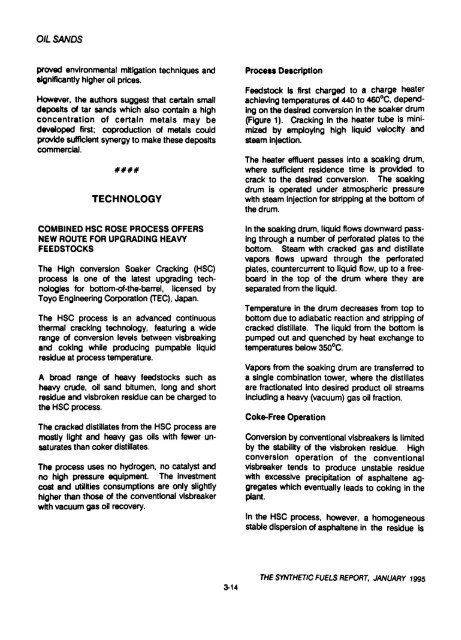Ikelic - Alliance Digital Repository
Ikelic - Alliance Digital Repository
Ikelic - Alliance Digital Repository
Create successful ePaper yourself
Turn your PDF publications into a flip-book with our unique Google optimized e-Paper software.
OIL SANDS<br />
proved environmental mitigation techniques and<br />
significantly<br />
higher oil prices.<br />
However, the authors suggest that certain small<br />
deposits of tar sands which also contain a high<br />
concentration of certain metals may be<br />
developed first; coproduction of metals could<br />
provide sufficient synergy to make these deposits<br />
commercial.<br />
####<br />
TECHNOLOGY<br />
COMBINED HSC ROSE PROCESS OFFERS<br />
NEW ROUTE FOR UPGRADING HEAVY<br />
FEEDSTOCKS<br />
The High conversion Soaker Cracking (HSC)<br />
process is one of the latest upgrading tech<br />
nologies for bottom-of-the-barrel, licensed by<br />
Toyo Engineering Corporation (TEC), Japan.<br />
The HSC process is an advanced continuous<br />
thermal cracking technology, featuring a wide<br />
range of conversion levels between visbreaking<br />
and coking while producing pumpable liquid<br />
residue at process temperature.<br />
A broad range of heavy feedstocks such as<br />
heavy crude, oil sand bitumen, long and short<br />
residue and visbroken residue can be charged to<br />
the HSC process.<br />
The cracked distillates from the HSC process are<br />
mostly light and heavy gas oils with fewer un<br />
saturates than coker distillates.<br />
The process uses no hydrogen, no catalyst and<br />
no high pressure equipment. The investment<br />
cost and utilities consumptions are only slightly<br />
higher than those of the conventional visbreaker<br />
with vacuum gas oil recovery.<br />
3-14<br />
Process Description<br />
Feedstock is first charged to a charge heater<br />
achieving temperatures of 440 to 460C, depend<br />
ing<br />
(Figure 1). Cracking<br />
on the desired conversion in the soaker drum<br />
in the heater tube is mini<br />
mized by employing high liquid velocity and<br />
steam injection.<br />
The heater effluent passes into a soaking drum,<br />
where sufficient residence time is provided to<br />
crack to the desired conversion. The soaking<br />
drum is operated under atmospheric pressure<br />
with steam injection for stripping at the bottom of<br />
the drum.<br />
In the soaking drum, liquid flows downward pass<br />
ing<br />
through a number of perforated plates to the<br />
bottom. Steam with cracked gas and distillate<br />
vapors flows upward through the perforated<br />
plates, countercurrent to liquid flow, up to a free<br />
board in the top of the drum where they are<br />
separated from the liquid.<br />
Temperature in the drum decreases from top to<br />
bottom due to adiabatic reaction and stripping of<br />
cracked distillate. The liquid from the bottom is<br />
pumped out and quenched by heat exchange to<br />
temperatures below 350C.<br />
Vapors from the soaking drum are transferred to<br />
a single combination tower, where the distillates<br />
are fractionated into desired product oil streams<br />
including a heavy (vacuum) gas oil fraction.<br />
Coke-Free Operation<br />
Conversion by conventional visbreakers is limited<br />
by the stability of the visbroken residue. High<br />
conversion operation of the conventional<br />
visbreaker tends to produce unstable residue<br />
with excessive precipitation of asphaltene ag<br />
gregates which eventually leads to coking in the<br />
plant.<br />
In the HSC process, however, a homogeneous<br />
stable dispersion of asphaltene in the residue is<br />
THE SYNTHETIC FUELS REPORT, JANUARY 1995















![pace SrntfletIc fne]its report - Alliance Digital Repository](https://img.yumpu.com/10493335/1/190x245/pace-srntfletic-fneits-report-alliance-digital-repository.jpg?quality=85)
